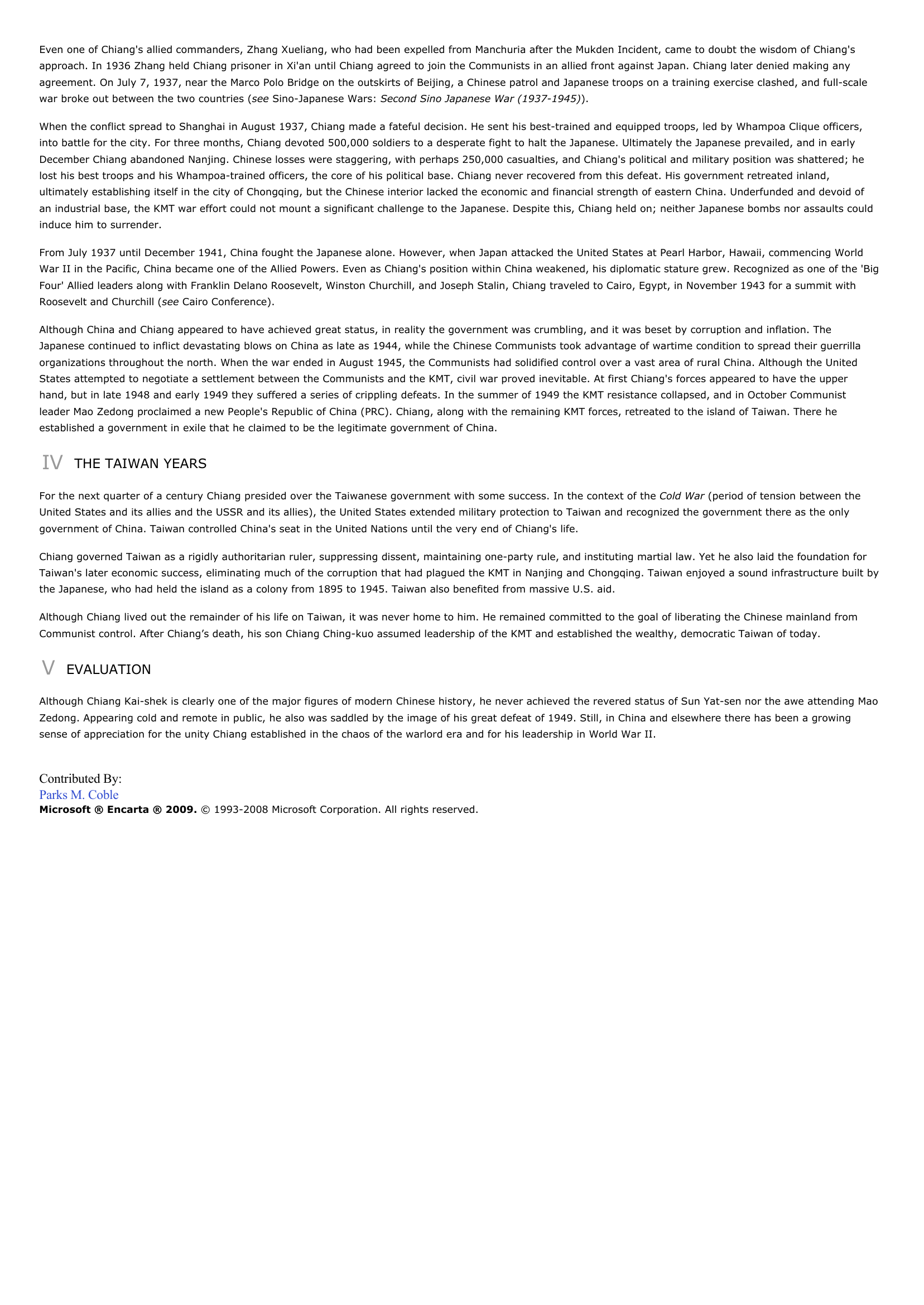Chiang Kai-shek - History.
Publié le 02/05/2013

Extrait du document
«
Even one of Chiang's allied commanders, Zhang Xueliang, who had been expelled from Manchuria after the Mukden Incident, came to doubt the wisdom of Chiang'sapproach.
In 1936 Zhang held Chiang prisoner in Xi'an until Chiang agreed to join the Communists in an allied front against Japan.
Chiang later denied making anyagreement.
On July 7, 1937, near the Marco Polo Bridge on the outskirts of Beijing, a Chinese patrol and Japanese troops on a training exercise clashed, and full-scalewar broke out between the two countries ( see Sino-Japanese Wars: Second Sino Japanese War (1937-1945) ).
When the conflict spread to Shanghai in August 1937, Chiang made a fateful decision.
He sent his best-trained and equipped troops, led by Whampoa Clique officers,into battle for the city.
For three months, Chiang devoted 500,000 soldiers to a desperate fight to halt the Japanese.
Ultimately the Japanese prevailed, and in earlyDecember Chiang abandoned Nanjing.
Chinese losses were staggering, with perhaps 250,000 casualties, and Chiang's political and military position was shattered; helost his best troops and his Whampoa-trained officers, the core of his political base.
Chiang never recovered from this defeat.
His government retreated inland,ultimately establishing itself in the city of Chongqing, but the Chinese interior lacked the economic and financial strength of eastern China.
Underfunded and devoid ofan industrial base, the KMT war effort could not mount a significant challenge to the Japanese.
Despite this, Chiang held on; neither Japanese bombs nor assaults couldinduce him to surrender.
From July 1937 until December 1941, China fought the Japanese alone.
However, when Japan attacked the United States at Pearl Harbor, Hawaii, commencing WorldWar II in the Pacific, China became one of the Allied Powers.
Even as Chiang's position within China weakened, his diplomatic stature grew.
Recognized as one of the 'BigFour' Allied leaders along with Franklin Delano Roosevelt, Winston Churchill, and Joseph Stalin, Chiang traveled to Cairo, Egypt, in November 1943 for a summit withRoosevelt and Churchill ( see Cairo Conference).
Although China and Chiang appeared to have achieved great status, in reality the government was crumbling, and it was beset by corruption and inflation.
TheJapanese continued to inflict devastating blows on China as late as 1944, while the Chinese Communists took advantage of wartime condition to spread their guerrillaorganizations throughout the north.
When the war ended in August 1945, the Communists had solidified control over a vast area of rural China.
Although the UnitedStates attempted to negotiate a settlement between the Communists and the KMT, civil war proved inevitable.
At first Chiang's forces appeared to have the upperhand, but in late 1948 and early 1949 they suffered a series of crippling defeats.
In the summer of 1949 the KMT resistance collapsed, and in October Communistleader Mao Zedong proclaimed a new People's Republic of China (PRC).
Chiang, along with the remaining KMT forces, retreated to the island of Taiwan.
There heestablished a government in exile that he claimed to be the legitimate government of China.
IV THE TAIWAN YEARS
For the next quarter of a century Chiang presided over the Taiwanese government with some success.
In the context of the Cold War (period of tension between the United States and its allies and the USSR and its allies), the United States extended military protection to Taiwan and recognized the government there as the onlygovernment of China.
Taiwan controlled China's seat in the United Nations until the very end of Chiang's life.
Chiang governed Taiwan as a rigidly authoritarian ruler, suppressing dissent, maintaining one-party rule, and instituting martial law.
Yet he also laid the foundation forTaiwan's later economic success, eliminating much of the corruption that had plagued the KMT in Nanjing and Chongqing.
Taiwan enjoyed a sound infrastructure built bythe Japanese, who had held the island as a colony from 1895 to 1945.
Taiwan also benefited from massive U.S.
aid.
Although Chiang lived out the remainder of his life on Taiwan, it was never home to him.
He remained committed to the goal of liberating the Chinese mainland fromCommunist control.
After Chiang’s death, his son Chiang Ching-kuo assumed leadership of the KMT and established the wealthy, democratic Taiwan of today.
V EVALUATION
Although Chiang Kai-shek is clearly one of the major figures of modern Chinese history, he never achieved the revered status of Sun Yat-sen nor the awe attending MaoZedong.
Appearing cold and remote in public, he also was saddled by the image of his great defeat of 1949.
Still, in China and elsewhere there has been a growingsense of appreciation for the unity Chiang established in the chaos of the warlord era and for his leadership in World War II.
Contributed By:Parks M.
CobleMicrosoft ® Encarta ® 2009. © 1993-2008 Microsoft Corporation.
All rights reserved..
»
↓↓↓ APERÇU DU DOCUMENT ↓↓↓
Liens utiles
- Chiang Kai-shek - Biography.
- Tchang Kaï-chek (Chiang Kai-shek)
- CHIANG KAI-SHEK (1887-1975) : le «Gemo».
- Tchang Kaï-chek (Chiang Kai-shek)
- Ideology and Rationality in the History of the Life Sciences








